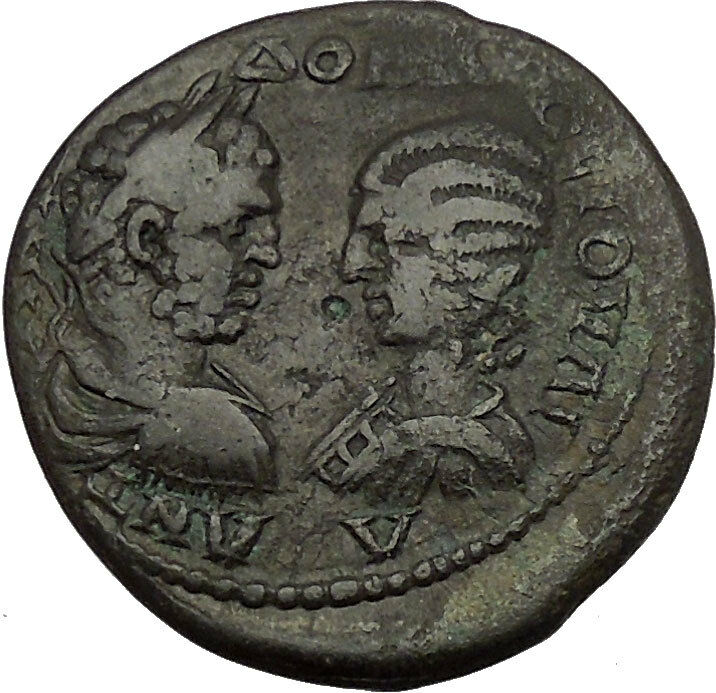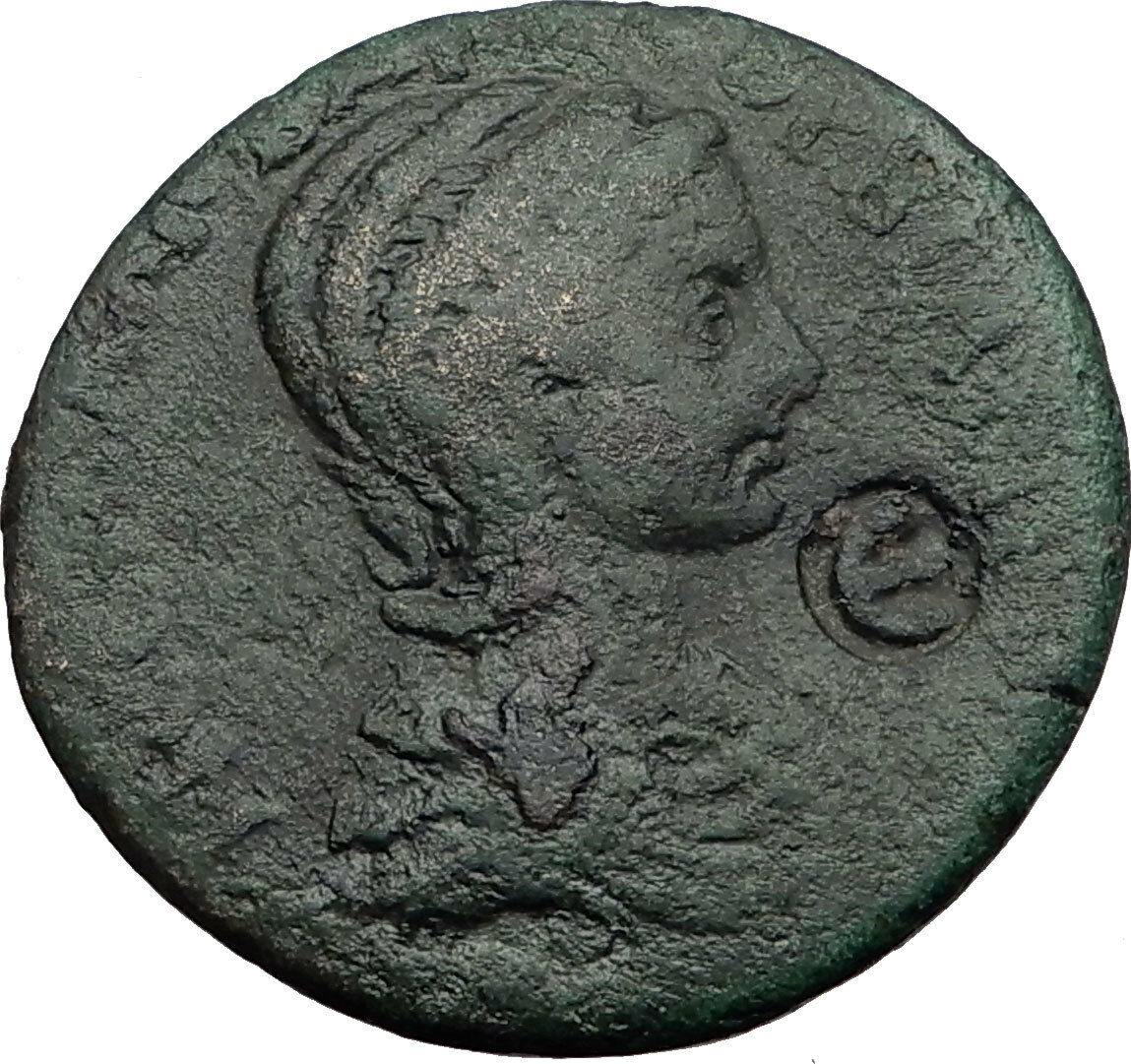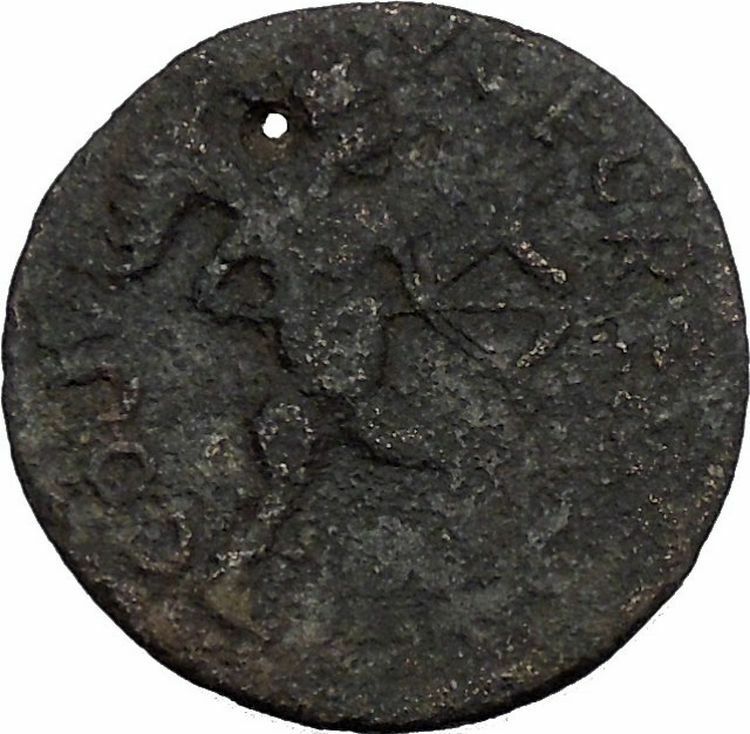|
Caracalla
–
Roman Emperor
: 198-217 A.D. –
Bronze 23mm (5.06 grams) of
Thessalonica
<=”” font=”” color=”#000000″ face=”Times New Roman”>
in
Macedonia
Laureate head right.
ΘЄCCAΛONIKЄΩN, <=”” font=”” color=”#000000″ face=”Times New Roman”>
Victory
advancing right, holding shield.
You are bidding on the exact item pictured,
provided with a Certificate of Authenticity and Lifetime Guarantee of
Authenticity.
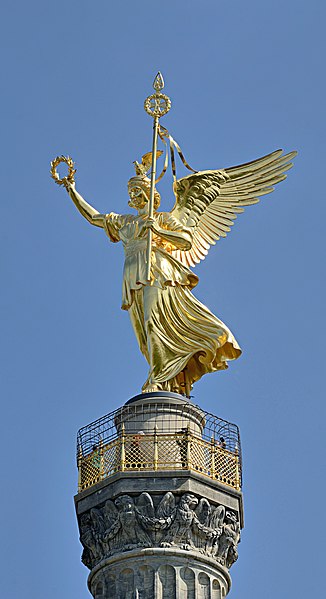
In
ancient Roman religion
, Victoria was the
personified
goddess of victory. She is the
Roman equivalent
of the
Greek goddess
Nike
, and was associated with
Bellona
. She was adapted from the
Sabine
agricultural goddess
Vacuna
and had a
temple
on the
Palatine Hill
. The goddess
Vica Pota
was also sometimes identified with
Victoria.
Unlike the Greek
Nike
, the goddess Victoria (Latin
for “victory”) was a major part of Roman society. Multiple temples were erected
in her honor. When her statue was removed in 382 CE by Emperor
Gratianus
there was much anger in Rome. She was
normally worshiped by
triumphant
generals returning from war.
Also unlike the Greek Nike, who was known for success in athletic games such
as
chariot races
, Victoria was a symbol of victory
over death and determined who would be successful during war.
Victoria appears widely on Roman coins, jewelry, architecture, and other
arts. She is often seen with or in a
chariot
, as in the late 18th-century sculpture
representing Victory in a
quadriga
on the
Brandenburg Gate
in
Berlin
, Germany; “Il Vittoriano”
in Rome has two.
Winged figures, very often in pairs, representing victory and referred to as
“victories”, were common in Roman official iconography, typically hovering high
in a composition, and often filling spaces in
spandrels
or other gaps in architecture. These
represent the spirit of victory rather than the goddess herself. They continued
to appear after Christianization of the Empire, and slowly mutated into
Christian angels
.
<=”” span=””>
The city was founded around
315 BC
by the
King Cassander of Macedon
, on or near the
site of the ancient town of
Therma
and twenty-six other local villages.
He named it after his wife
Thessalonike
, a half-sister of
Alexander the Great
. She gained her name
(“victory of Thessalians”: Gk
nikē
“victory”) from her father,
Philip II
, to commemorate her birth on the
day of his gaining a victory over the
Phocians
, who were defeated with the help
of
Thessalian
horsemen, the best in Greece at
that time. Thessaloniki developed rapidly and as early as the
2nd century BC
the first walls were built,
forming a large square. It was an autonomous part of the Kingdom of
Macedon
, with its own parliament where the
King was represented and could interfere in the city’s domestic affairs.
Roman
era
After the fall of the kingdom of Macedon in
168 BC
, Thessalonica became a city of the
Roman Republic
. It grew to be an important
trade-hub located on the
Via Egnatia
, the
Roman road
connecting
Byzantium
(later
Constantinople
), with
Dyrrhachium
(now
Durrës
in
Albania
), and facilitating trade between
Europe and Asia. The city became the capital of one of the four Roman
districts of Macedonia; it kept its privileges but was ruled by a
praetor
and had a Roman garrison, while for
a short time in the
1st century BC
, all the Greek provinces
came under Thessalonica (the Latin form of the name). Due to the city’s key
commercial importance, a spacious harbour was built by the Romans, the
famous Burrowed Harbour (Σκαπτός Λιμήν) that accommodated the town’s
trade up to the eighteenth century; later, with the help of silt deposits
from the river Axios
, it was reclaimed as land and the
port built beyond it. Remnants of the old harbour’s docks can be found in
the present day under Odos Frangon Street, near the Catholic Church.
Thessaloniki’s
acropolis
, located in the northern hills,
was built in 55 BC
after
Thracian
raids in the city’s outskirts, for
security reasons.
The city had a
Jewish
colony, established during the
first century
, and was to be an early
centre of
Christianity
. On his second missionary
journey,
Paul
of Tarsus
, born a Hellenized Israelite,
preached in the city’s synagogue, the chief synagogue of the Jews in that
part of Thessaloniki, and laid the foundations of a church. Other Jews
opposed to Paul drove him from the city, and he fled to
Veroia
. Paul wrote two of his
epistles
to the Christian community at
Thessalonica, the
First Epistle to the Thessalonians
and the
Second Epistle to the Thessalonians
.
Thessaloníki acquired a patron saint,
St. Demetrius
, in 306. He is credited with
a number of miracles that saved the city, and was the Roman
Proconsul
of Greece under the
anti-Christian emperor
Maximian
, later martyred at a Roman prison
where today lies the
Church of St. Demetrius
, first built by the
Roman sub-prefect of
Illyricum
Leontios in 463. Other important
remains from this period include the
Arch and Tomb of Galerius
, located near the
centre of the modern city.
Caracalla (Latin:
Marcus Aurelius Severus Antoninus Augustus;4
April 188 – 8 April 217) was
Roman emperor
from 198 to 217 The eldest
son of
Septimius Severus
, for a short time he
ruled jointly with his younger brother
Geta
until he had him murdered in 211.
Caracalla is remembered as one of the most notorious and unpleasant of
emperors because of the massacres and persecutions he authorized and
instigated throughout the Empire.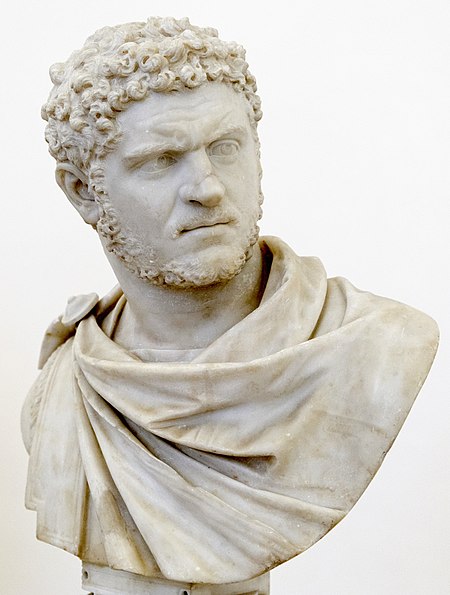
Caracalla’s reign was also notable for the
Constitutio Antoniniana
(also called
the Edict of Caracalla), granting
Roman citizenship
to all freemen throughout
the Roman Empire
, which according to historian
Cassius Dio
, was done for the purposes of
raising tax revenue. He is also one of the emperors who commissioned a large
public bath-house (thermae)
in Rome. The remains of the
Baths of Caracalla
are still one of the
major tourist attractions of the Italian capital.
Early life
Caracalla, of mixed
Punic
–Roman
and Syrian
descent, was born Lucius Septimius
Bassianus in
Lugdunum
,
Gaul
(now
Lyon
,
France
), the son of the later Emperor
Septimius Severus and
Julia Domna
. At the age of seven, his name
was changed to Marcus Aurelius Septimius Bassianus Antoninus to create a
connection to the family of the philosopher emperor
Marcus Aurelius
. He was later given the
Caracallanickname
,
which referred to the Gallic hooded tunic he habitually wore and which he
made fashionable.
Reign (211)
Murder of
brother (211)
His father died in 211 at
Eboracum
(now
York
) while on campaign in northern
Britain. Caracalla was present and was then proclaimed emperor by the troops
along with his brother
Publius Septimius Antoninus Geta
. Caracalla
suspended the
campaign in Caledonia
and soon ended all
military activity, as both brothers wanted to be sole ruler thus making
relations between them increasingly hostile. When they tried to rule the
Empire jointly they actually considered dividing it in halves, but were
persuaded not to do so by their mother.
Then in December 211 at a reconciliation meeting arranged by their mother
Julia, Caracalla had Geta assassinated by members of the Praetorian Guard
loyal to himself, Geta dying in his mother’s arms. Caracalla then persecuted
and executed most of Geta’s supporters and ordered a
damnatio memoriae
pronounced by the
Senate against his brother’s memory.
Geta’s image was simply removed from all coinage, paintings and statues,
leaving a blank space next to Caracalla’s. Among those executed were his
former cousin-wife
Fulvia Plautilla
, his unnamed daughter with
Plautilla along with her brother and other members of the family of his
former father-in-law
Gaius Fulvius Plautianus
. Plautianus had
already been executed for alleged treachery against emperor Severus in 205.
About the time of his accession he ordered the
Roman currency
devalued, the silver purity
of the denarius
was decreased from 56.5% to 51.5%,
the actual silver weight dropping from 1.81 grams to 1.66 grams – though the
overall weight slightly increased. In 215 he introduced the
antoninianus
, a “double denarius”
weighing 5.1 grams and containing 2.6 grams of silver – a purity of 52%.
In the Roman
provinces
In 213, Caracalla went north to the German frontier to deal with the
Alamanni
tribesmen who were raiding in the
Agri Decumates
. The Romans did defeat the
Alamanni in battle near the river
Main
, but failed to win a decisive victory
over them. After a peace agreement was brokered and a large bribe payment
given to the invaders, the Senate conferred upon him the empty title of
Germanicus Maximus. He also acquired the surname Alemannicus at
this time. The following year the tyrant traveled to the East, to Syria and
Egypt never to return to Rome.
Gibbon
in his work describes Caracalla as
“the common enemy of mankind”. He left the capital in 213, about a year
after the murder of Geta, and spent the rest of his reign in the provinces,
particularly those of the East. He kept the Senate and other wealthy
families in check by forcing them to construct, at their own expense,
palaces, theaters, and places of entertainment throughout the periphery. New
and heavy taxes were levied against the bulk of the population, with
additional fees and confiscations targeted at the wealthiest families.
When the inhabitants of
Alexandria
heard Caracalla’s claims that he
had killed Geta in self-defense, they produced a satire mocking this as well
as Caracalla’s other pretensions. In 215, Caracalla savagely responded to
this insult by slaughtering the deputation of leading citizens who had
unsuspectingly assembled before the city to greet his arrival, and then
unleashed his troops for several days of looting and plunder in Alexandria.
According to historian Cassius Dio, over 20,000 people were killed.[citation
needed]
Domestic Roman
policy
Affiliation
with the army
During his reign as emperor, Caracalla raised the annual pay of an
average legionary to 675
denarii
and lavished many benefits on
the army which he both feared and admired, as instructed by his father
Septimius Severus who had told him on his deathbed to always mind the
soldiers and ignore everyone else. Caracalla did manage to win the trust of
the military with generous pay rises and popular gestures, like marching on
foot among the ordinary soldiers, eating the same food, and even grinding
his own flour with them.
With the soldiers, “He forgot even the proper dignity of his rank,
encouraging their insolent familiarity,” according to Gibbon. “The vigour of
the army, instead of being confirmed by the severe discipline of the camps,
melted away in the luxury of the cities.”

|
O:
laureate
head of Caracalla
ANTONINVS
PIVS
AVG
GERM
|
R:
Sol
holding
globe
, rising hand
P M
TR P
_XVIIII
COS
IIII
P P
|
|
silver
denarius
struck in
Rome
216; ref.: RIC 281b, C 359 |
His official portraiture marks a break with the detached images of the
philosopher–emperors who preceded him: his close-cropped haircut is that of
a soldier, his pugnacious scowl a realistic and threatening presence. This
rugged soldier–emperor iconic archetype was adopted by most of the following
emperors who depended on the support of the troops to rule, like his
eventual successor
Maximinus Thrax
.
Seeking to secure his own legacy, Caracalla also commissioned one of
Rome’s last major architectural achievements, the
Baths of Caracalla
, the 2nd largest public
baths ever built in ancient Rome. The main room of the baths was larger than
St. Peter’s Basilica
, and could easily
accommodate over 2,000 Roman citizens at one time. The bath house opened in
216, complete with libraries, private rooms and outdoor tracks. Internally
it was lavishly decorated with gold-trimmed marble floors, columns, mosaics
and colossal statuary.
Edict of
Caracalla (212)
The
Constitutio Antoniniana
(Latin:
“Constitution [or Edict] of Antoninus”) (also called Edict of Caracalla)
was an edict issued in 212 by Caracalla which declared that all free men in
the Roman Empire were to be given full Roman citizenship and all free women
in the Empire were given the same rights as Roman women.
Before 212, for the most part only inhabitants of Italia held full Roman
citizenship. Colonies of Romans established in other provinces, Romans (or
their descendants) living in provinces, the inhabitants of various cities
throughout the Empire, and small numbers of local nobles (such as kings of
client countries) held full citizenship also. Provincials, on the other
hand, were usually non-citizens, although many held the
Latin Right
.
The Roman Historian
Cassius Dio
contended that the sole
motivation for the edict was a desire to increase state revenue.At the time
aliens did not have to pay most taxes that were required of citizens, so
although nominally Caracalla was elevating their legal status, he was more
importantly expanding the Roman tax base. The effect of this was to remove
the distinction that citizenship had held since the foundation of Rome and
as such the act had a profound effect upon the fabric of Roman society.[16]
War with Parthia
According to the historian Herodian, in 216, Caracalla tricked the
Parthians into believing that he accepted a marriage and peace proposal, but
then had the bride and guests slaughtered after the wedding celebrations.
The thereafter ongoing conflict and skirmishes became known as the
Parthian war of Caracalla
.
Assassination
(217)
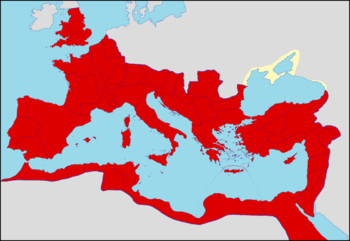
The Roman Empire during the reign of Caracalla.
While travelling from
Edessa
to continue the war with
Parthia
, he was assassinated while
urinating at a roadside near
Carrhae
on 8 April 217 (4 days after his
29th birthday), by Julius Martialis, an officer of his personal bodyguard.
Herodian
says that Martialis’ brother had
been executed a few days earlier by Caracalla on an unproven charge; Cassius
Dio, on the other hand, says that Martialis was resentful at not being
promoted to the rank of centurion. The escort of the emperor gave him
privacy to relieve himself, and Martialis then ran forward and killed
Caracalla with a single sword stroke. While attempting to flee, the bold
assassin was then quickly dispatched by a Scythian archer of the Imperial
Guard.
Caracalla was succeeded by his
Praetorian Guard Prefect
,
Macrinus
, who (according to Herodian) was
most probably responsible for having the emperor assassinated.
His nickname
According to
Aurelius Victor
in his Epitome de
Caesaribus, the
agnomen
“Caracalla” refers to a Gallic
cloak
that Caracalla adopted as a personal
fashion, which spread to his army and his court. Cassius Dio and the
Historia Augusta
agree that his
nickname was derived from his cloak, but do not mention its country of
origin.
Legendary king
of Britain
Geoffrey of Monmouth
‘s legendary
History of the Kings of Britain
makes
Caracalla a king of Britain, referring to him by his actual name “Bassianus”,
rather than the nickname Caracalla. In the story, after Severus’s death the
Romans wanted to make Geta king of Britain, but the Britons preferred
Bassianus because he had a British mother. The two brothers fought a battle
in which Geta was killed and Bassianus succeeded to the throne. He ruled
until he was betrayed by his
Pictish
allies and overthrown by
Carausius
, who, according to Geoffrey, was
a Briton, rather than the historically much later
Menapian
Gaul that he actually was.
|










